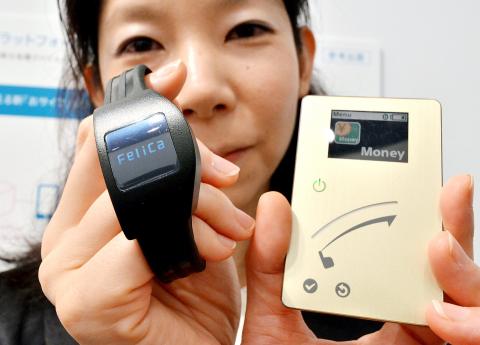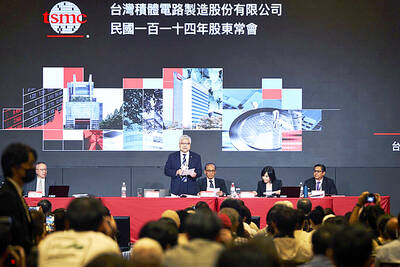Apple Inc’s proud announcement that its new iPhone could be used to buy goods in a single swipe left customers nonplussed in Japan, where mobile contactless payments have been normal fare for a decade.
A type of Near Field Communication (NFC) chip, known in Japan as Felica, was introduced to the Japanese mobile market in June 2004 and has been been implanted in almost all phones sold in the country since.
The iPhone has been one of the few chipless exceptions — something that will change with the new models to hit Japanese shelves on Sept. 19.

Photo: AFP
Ten years ago the charismatic Takeshi Natsuno, who was then multimedia services director of Japanese mobile operator NTT Docomo Inc, extolled the benefits of swapping cash for cellphones.
“When I leave my house in the morning all I take with me is my phone, which lets me do everything — pay, take public transport — simply by swiping a special reader in shops, stations or airports,” he said at the time.
Felica was conceived by Sony Corp way back in 1989 and first used in the Hong Kong underground railway system in 1997 — in a card known as Octopus — inspiring cities around the world to use similar technology in their own contactless transport cards.
Japan adopted an electronic payment system for trains in 2001, starting with the JR East network, which serves the Tokyo region.
The transport cards’ success led to the integration of contactless chips into Japanese mobile phones and lifestyles with the creation of a group of apps known as the mobile wallet by NTT Docomo in 2004.
Thousands of readers are now installed in convenience stores, on vending machines, in office buildings, and at stations and airports in Japan.
Contactless payments are a normal part of everyday life for many Japanese people, said Michael Au, president of the South Asia and Japan branch of digital security firm Gemalto.
"Japan has the most developed contactless infrastructure in the world and customers are already familiar with using their mobiles for contactless services," he said.
Sony, which said it has delivered more than 530 million Felica chips for cards and 245 million for mobile phones, is now responsible for making about 100 various services based on the technology compatible with each other.
NFC was approved as a standard in 2003, as the fruit of cooperation between Sony and Dutch company Philips Semiconductors, which is now known as NXP Semiconductors NV.
The huge success at home that has not translated into sales abroad is a common theme in Japan, where companies have tended to focus on the large home market and its particularly fussy consumers.
This has led to a phenomenon dubbed the “Galapagos Syndrome.” Technology in Japan has a tendency to develop without reference to other parts of the planet — similar to animals found on the remote Galapagos Islands — and is then incompatible with foreign market standards.
The most well-known example of this is the mobile phone, where Japan was initially streets ahead and had polyphonal, full-color flip-top mobile phones in the late 1990s.
These units were Internet-capable as far back as 1999.
However, the technology ossified and Japan was a relative latecomer to the smartphone market.
This “Galapagos-ization” has also been remarked in the video game, car and audio markets, with products such as the MiniDisc, compact cars and manga-inspired games all failing to make the same headway overseas as in Japan.
Natsuno, who is now a professor at Keio University in Tokyo, says Japan should have looked into overseas expansion of its cutting edge contactless payments system much sooner.
The fact that “we didn’t extend this concept to the rest of the world” means that now Japan “can’t do anything” about Apple’s bragging over their innovative iPhone 6 with an NFC chip, he said.

CAUTIOUS RECOVERY: While the manufacturing sector returned to growth amid the US-China trade truce, firms remain wary as uncertainty clouds the outlook, the CIER said The local manufacturing sector returned to expansion last month, as the official purchasing managers’ index (PMI) rose 2.1 points to 51.0, driven by a temporary easing in US-China trade tensions, the Chung-Hua Institution for Economic Research (CIER, 中華經濟研究院) said yesterday. The PMI gauges the health of the manufacturing industry, with readings above 50 indicating expansion and those below 50 signaling contraction. “Firms are not as pessimistic as they were in April, but they remain far from optimistic,” CIER president Lien Hsien-ming (連賢明) said at a news conference. The full impact of US tariff decisions is unlikely to become clear until later this month

With an approval rating of just two percent, Peruvian President Dina Boluarte might be the world’s most unpopular leader, according to pollsters. Protests greeted her rise to power 29 months ago, and have marked her entire term — joined by assorted scandals, investigations, controversies and a surge in gang violence. The 63-year-old is the target of a dozen probes, including for her alleged failure to declare gifts of luxury jewels and watches, a scandal inevitably dubbed “Rolexgate.” She is also under the microscope for a two-week undeclared absence for nose surgery — which she insists was medical, not cosmetic — and is

GROWING CONCERN: Some senior Trump administration officials opposed the UAE expansion over fears that another TSMC project could jeopardize its US investment Taiwan Semiconductor Manufacturing Co (TSMC, 台積電) is evaluating building an advanced production facility in the United Arab Emirates (UAE) and has discussed the possibility with officials in US President Donald Trump’s administration, people familiar with the matter said, in a potentially major bet on the Middle East that would only come to fruition with Washington’s approval. The company has had multiple meetings in the past few months with US Special Envoy to the Middle East Steve Witkoff and officials from MGX, an influential investment vehicle overseen by the UAE president’s brother, the people said. The conversations are a continuation of talks that

CHIP DUTIES: TSMC said it voiced its concerns to Washington about tariffs, telling the US commerce department that it wants ‘fair treatment’ to protect its competitiveness Taiwan Semiconductor Manufacturing Co (TSMC, 台積電) yesterday reiterated robust business prospects for this year as strong artificial intelligence (AI) chip demand from Nvidia Corp and other customers would absorb the impacts of US tariffs. “The impact of tariffs would be indirect, as the custom tax is the importers’ responsibility, not the exporters,” TSMC chairman and chief executive officer C.C. Wei (魏哲家) said at the chipmaker’s annual shareholders’ meeting in Hsinchu City. TSMC’s business could be affected if people become reluctant to buy electronics due to inflated prices, Wei said. In addition, the chipmaker has voiced its concern to the US Department of Commerce